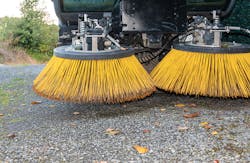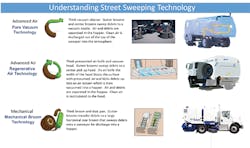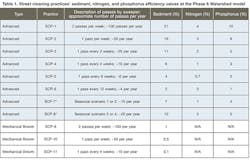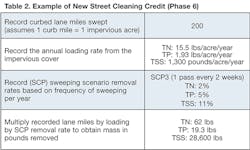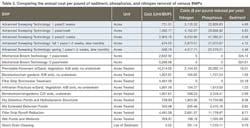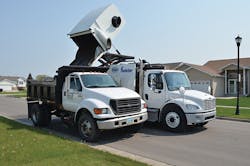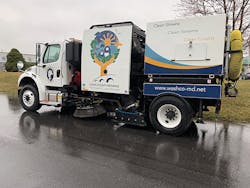As stewards of taxpayer dollars, stormwater managers must implement a portfolio of the most cost effective best management practices (BMPs) that meet the US Envrionmental Protection Agency’s Final MS4 General Permit Remand Rule requiring “clear, specific, and measurable permitting” conditions while also keeping the public informed and involved. To achieve this objective, the Chesapeake Bay Program is leading the way with tools and guides to help stormwater managers. Partners of the program include federal and state agencies, local governments, non-profit organizations and academic institutions.The Chesapeake Bay Program has developed a comprehensive online tool called the Chesapeake Assessment Scenario Tool, also known as CAST. CAST enables stormwater managers from each county within the six-state Chesapeake Bay region to develop their Phase 3 Watershed Implementation Plans (WIP). It estimates the nitrogen, phosphorus, and sediment loads resulting from selecting one or more BMPs to achieve their goals. The results also quantify the costs and effectiveness of various BMPs. Many of the scenarios break BMPs down to similar units of measure, like cost per acre of treatment, so that stormwater managers can easily compare one BMP to another.
The Chesapeake Bay Program also recently developed a downloadable BMP guide entitled Chesapeake Bay Program Quick Reference Guide for Best Management Practices (BMPs). One objective of the guide is to provide consistent understanding of BMPs that reduce sediment, nitrogen, and phosphorus. A summary for each BMP includes
- general information about the BMP;
- how the BMP functions within the Watershed Model;
- what’s needed for the BMP to be reported for annual progress submissions;
- and links to additional information for readers who want more detailed information about the practice.
Street Sweepers Stand Out
Street sweepers with catch basin cleaning capability stand out as one of the most cost-effective BMPs.
Within the comprehensive guide are several quick reference guides ranging from stream restoration to street sweeping. The street sweeping guide was developed using WinSLAMM software modeling. Inputs include default nutrient enrichment factors of .07% phosphorus and .20% nitrogen for street solids. These means were based on several street solid studies across the US and were found to be surprisingly consistent. Rainfall data was entered once every four days which is typical for the Chesapeake Bay region. Other input data included regional street conditions, street types, parking density, and the type of sweeper technology.
The model was used to simulate the reduction for 960 different street cleaning scenarios, but was eventually consolidated into 11 generic scenarios; because 65% of the scenarios showed no pollution reduction benefit, they were eliminated. The street sweeping guidelines quantify TMDL reductions based on frequency and the type of sweeping technology used, whether it be mechanical or advanced air sweeping. The guide includes a table that breaks down 11 street cleaning practices (SCPs), examples of which can be seen in Table 1. Emphasis is placed on frequency of sweeping to ensure the removal of accumulated material before precipitation washes it into storm drains or waterways. A general guideline for the MS4 in terms of treatment is one mile of curb lane swept is equal to one impervious acre of treatment. The guide quantifies TMDL reductions in terms of percentages for sediment, phosphorus, and nitrogen. For example, MS4s operating advanced air technology, such as regenerative air or pure vacuum sweepers, earn the maximum credit of 21% Sediment, 4% Nitrogen, and 10% Phosphorus when sweeping routes twice per week, 50 weeks per year. The street sweeping guide can be found at www.chesapeakebay.net/documents/BMP-Guide_D.9_Street-Cleaning-Street-Sweeping_.pdf.
In the example in Table 2, the stormwater manager records the curbed lane miles swept. Annual TMDL loading is factored based on scenarios offered in CAST or as actually determined by the stormwater manager. Once the percent reduction is applied, the stormwater manager can then determine the actual removal rate. It is also important to note that stormwater managers must collect one high-quality sample on one route for each SCP for credit each year.
Applying The Tools to Find the Fastest Way to Reach TMDL Goals
The State of Maryland’s Phase 3 Watershed Implementation Plan (WIP) is the state’s plan to reduce sediment, nitrogen, and phosphorus TMDLs by 2025. Each county within the state must develop a watershed implementation plan (WIP) which outlines how it will meet TMDL target loads for the urban, wastewater, and septic sectors. Washington County, MD, operates under an NPDES Phase II permit. The County is made up of 22,162 acres with a population of 150,926. Washington County’s 2017 to 2025 total reduction responsibility is 10,631 TN pounds and 581 TP pounds. This equates to a 20% reduction by 2025.
In order for Washington County to meet the Chesapeake Bay’s plan for both the NPDES permit and EPA total maximum daily load requirements, early modeling of various BMP scenarios within the CAST tallied up to more than a billion dollars.
“We really had to look at ways to become innovative and creative,” says Alex Reed, watershed specialist for Washington County.John Swauger, who serves as the stormwater management coordinator for Washington County, says it comes down to numbers. “We looked at some of the other BMPs and many of those are quite expensive to install. We start by looking at BMPs within the $20,000 per acre range for treatment. What we’ve calculated is that street sweeping will put us well below that $20,000 per acre of treatment, and is the quickest and fastest way to get started on the reduction of the 20 percent to meet our goal.” Using the CAST guidelines of advanced air sweepers making one pass every two weeks resulted in a cost of $731 per acre of treatment.
Therefore, the county opted to purchase an A8 Twister regenerative air sweeper from Schwarze Industries. Under the guidelines that one lane-mile of sweeping with a regenerative air sweeper equals one impervious acre treated, the staff separated the county into 45 “sweepable sections” that each will be swept 25 times per year, with a goal of sweeping at least 12 lane-miles per day.
The sweeper provides the county double functionality when it comes to BMPs—in addition to street sweeping, it also has catch basin cleaning capabilities. This was a feature that Washington County particularly sought when selecting the A8 Twister, Reed says. Using the CAST guidelines for catch basin cleaning, each pound of sediment removed results in a cost of $0.62 per pound.
“To make sure we got the right bang for the buck we decided to go with a sweeper that had a scissor lift option,” says Reed. “This enables us to have a dump truck staged in one of the 45 routes we have mapped out and to be able to dump three to four loads. Once the dump truck is full, it can go to the landfill, where it dumps the material into a pile, or to be dewatered and then comes back to be staged,” he says. “Then we never stop the street sweeper during the day while it’s out and about.”
The Added Benefit of Achieving Community Involvementand Buy-In
Because a sweeper is able to serve an entire county, people from communities across the economic spectrum are able to see it at work in their neighborhoods.
“A lot of the lower-income places and communities in the county, those are areas that have already been developed,” meaning there is not space for BMPs like storm ponds, explains Reed. A sweeper, however, can get into those communities and make a difference. “The debris is picked up and then all of a sudden these under-served communities aesthetically look better,” he says.
The public response has been overwhelmingly positive. “I’m honestly surprised—happily surprised—how many phone calls we’ve gotten from people calling to thank us,” says Reed.
Washington County also uses the sweeper to promote its Clean County Initiative, a program that aims to ensure taxpayer dollars are used effectively and create awareness of the county’s efforts to improve the environment. The sweeper features the Clean County Initiative logo and its motto, “Clean Streets, Clean Streams, Clean County.”
“People recognize it and they’re starting to associate that brand recognition with good work in the community,” says Reed, adding that it has benefited other BMPs such as stream cleanups and tree plantings at schools, which have recently experienced higher attendance. “As long as we have that community buy-in, we’re going to be able to continue to reach our goals and, therefore, be one of the counties that actually meets our NPDES goals, and that’s something we’re pretty fired up about. And doing that on limited resources—that’s even better.”
Since the inception of the Clean County street sweeper in January of 2019, over 1 million pounds of debris have been collected from the impervious streets and roadways across Washington County. The latest data on the amount of data collected to date can be found on the County’s website at www.bit.ly/2Q4sfh8. County Administrator Rob Slocum said during a recent press release, “Washington County is one million pounds cleaner and closer to its permit requirements with this program.”References
Chesapeake Bay Program. 2018. Chesapeake Bay Program Quick Reference Guide for Best Management Practices (BMPs): Nonpoint Source BMPs to Reduce Nitrogen, Phosphorus and Sediment Loads to the Chesapeake Bay and its Local Waters. CBP DOC ID. www.chesapeakebay.net/documents/BMP-Guide_Full.pdf
Chesapeake Bay Program. “D-9: Street Cleaning (Street Sweeping).” Chesapeake Bay Program Quick Reference Guide for Best Management Practices (BMPs): Nonpoint Source BMPs to Reduce Nitrogen, Phosphorus and Sediment Loads to the Chesapeake Bay and its Local Waters. October 10, 2018.
Washington County, Maryland. Division of Environmental Management Clean County Initiative. www.washco-md.net/enviromental-management/stormwater-management-prog/cleancounty/.
Washington County, Maryland. “Pounds of Debris Collected.” Division of Environmental Management Clean County Initiative. www.washco-md.net/enviromental-management/stormwater-management-prog/cleancounty/
Washington County, Maryland. “Clean County Street Sweeper Achieves One Million Pound Milestone.” County News. www.bit.ly/2EGs9ad. October 8, 2019.
About the Author
David Heigl
David Heigl is vice president of Schwarze Industries Since the 2017 release of the EPA’s Final MS4 General Permit Reprimand Rule, he has led a campaign to educate stormwater managers on recent third party guidelines for maximizing impervious acre treatment and TMDL reduction credits through the use of advanced street sweeping technology.
